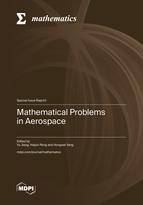Mathematical Problems in Aerospace
A special issue of Mathematics (ISSN 2227-7390). This special issue belongs to the section "Engineering Mathematics".
Deadline for manuscript submissions: closed (30 March 2023) | Viewed by 33189
Special Issue Editors
Interests: AI in aerospace
Interests: the theory and computation of optimal control and their applications in aerospace
Interests: astrodynamics; orbit design and optimization
Special Issues, Collections and Topics in MDPI journals
Special Issue Information
Mathematical problem in aerospace becomes a hot issue in recent years and has received more and more attention, and deeply affects the development of many fields, such as aerodynamics, astrodynamics, deep space exploration, space environment, manned space flight, etc. Notwithstanding the enormous efforts of mathematicians, natural scientists, and engineers, many major issues remain unresolved. Therefore, there is an urgent need to comprehensively introduce major mathematical problems in aerospace to help people refer to and conduct further in-depth research. This special issue is planned to provide an overview of the latest major mathematical problems in aerospace and their applications in different fields. The purpose of this special issue is to provide a partial contribution to the mathematical theory, computational methods and other issues involved in aerospace. Potential topics include, but are not limited to:
Rocket propulsion;
Planetary atmosphere;
Deep space exploration;
Aerodynamics;
Astrodynamics;
Guidance, navigation, and control;
Manned space flight;
Plume of spacecraft and aircraft;
Thermophysical of spacecraft and aircraft;
Debris, dust, meteoroid, asteroid, comet, planet;
Boundary of the Solar system;
Space environment.
Prof. Dr. Yu Jiang
Prof. Dr. Haijun Peng
Dr. Hongwei Yang
Guest Editors
Manuscript Submission Information
Manuscripts should be submitted online at www.mdpi.com by registering and logging in to this website. Once you are registered, click here to go to the submission form. Manuscripts can be submitted until the deadline. All submissions that pass pre-check are peer-reviewed. Accepted papers will be published continuously in the journal (as soon as accepted) and will be listed together on the special issue website. Research articles, review articles as well as short communications are invited. For planned papers, a title and short abstract (about 100 words) can be sent to the Editorial Office for announcement on this website.
Submitted manuscripts should not have been published previously, nor be under consideration for publication elsewhere (except conference proceedings papers). All manuscripts are thoroughly refereed through a single-blind peer-review process. A guide for authors and other relevant information for submission of manuscripts is available on the Instructions for Authors page. Mathematics is an international peer-reviewed open access semimonthly journal published by MDPI.
Please visit the Instructions for Authors page before submitting a manuscript. The Article Processing Charge (APC) for publication in this open access journal is 2600 CHF (Swiss Francs). Submitted papers should be well formatted and use good English. Authors may use MDPI's English editing service prior to publication or during author revisions.
Keywords
- Astrodynamics
- Dynamical system
- Space environment
- Invariant manifold
- Guidance, navigation, and control
- Aerospace
- Celestial Mechanics
- Planetary Science







